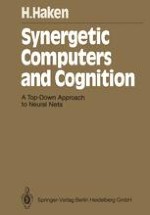1991 | OriginalPaper | Buchkapitel
Learning of Processes and Associative Action
verfasst von : Professor Dr. Dr. h.c. Hermann Haken
Erschienen in: Synergetic Computers and Cognition
Verlag: Springer Berlin Heidelberg
Enthalten in: Professional Book Archive
Aktivieren Sie unsere intelligente Suche, um passende Fachinhalte oder Patente zu finden.
Wählen Sie Textabschnitte aus um mit Künstlicher Intelligenz passenden Patente zu finden. powered by
Markieren Sie Textabschnitte, um KI-gestützt weitere passende Inhalte zu finden. powered by
While in the preceding chapter we did not prescribe the path (trajectory) along which the system reaches the final attractor states corresponding to the originally offered patterns (prototype patterns), we now wish to show that the system can even learn to reproduce specific paths (trajectories). Or, in other words, the system may learn to perform specific motions in its space of dynamic variables. While in Sects. 11.1 and 11.2 it will be assumed that all motions are taught, in Sect. 11.3 we shall study the case in which only examples are provided such that the system has to interpolate. It will turn out that we may proceed in analogy to Sect. 10.4, i.e., we first derive a Fokker-Planck equation by means of some generalization of the maximum information principle. We then establish an analogy to the Langevin equation which may be interpreted as a network (Sect. 11.2). The whole chapter is rather mathematical and its results will not be needed later in this book, but this approach has important potential for applications.
